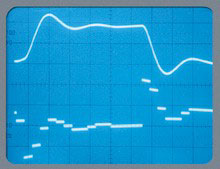
- Digital Controller implementation on µP -kit
- Simple Op-amp based analog plant
- CRO display of response
- Design and test new algorithms
INTRODUCTION :
Feedback is applied in a variety of systems to control different physical variables. In contrast with systems without feedback (open loop systems), the feedback systems (closed loop systems) have lower parameters sensitivity, higher disturbance rejection and greater accuracy. The light intensity control system is designed to bring out these features in the form of a laboratory experiment. The light panel comprises of a number of filament lamps which get power from amplifier. Average intensity of the panel is sensed by a light sensor and a suitable voltage level is produced. Error detector, reference input and error amplifier are of standard configurations found in any linear control system. In addition to the above, the light panel also contains a few uncontrolled lamps which may be used as disturbance source. Further a square wave signal is available for dynamic response studies. Measurement points are provided for monitoring the performance of the system. A detailed user’s manual comprising of the system description, experiments to be conducted and typical results is supplied with the set-up
EXPERIMENTS :
- Identification of the controlled process

- Study of sampling period variation
- Designing P, PI, PD and PID controllers
- Advanced algorithms implementation
FEATURES AND SPECIFICATIONS :
- Second order simulated process (analog process)
- Built-in D/A and A/D circuits (8-bit)
- 8085 based µP kit as digital controller with user software in 8K EPROM
- 16-bit arithmetic for algorithmic calculations
- 16 built-in levels of P, I and D gains each. Complete flexibility for the user to develop own software
- Square wave test input (internal)
- IC regulated internal built-in power supplies
- 220V±10%, 50Hz mains operation
- Detailed literature and patch cords included
- Essential accessory – a CRO

Note: There may be any change in specification due to continuous R & D without notice.
Click below to view cat
.png)